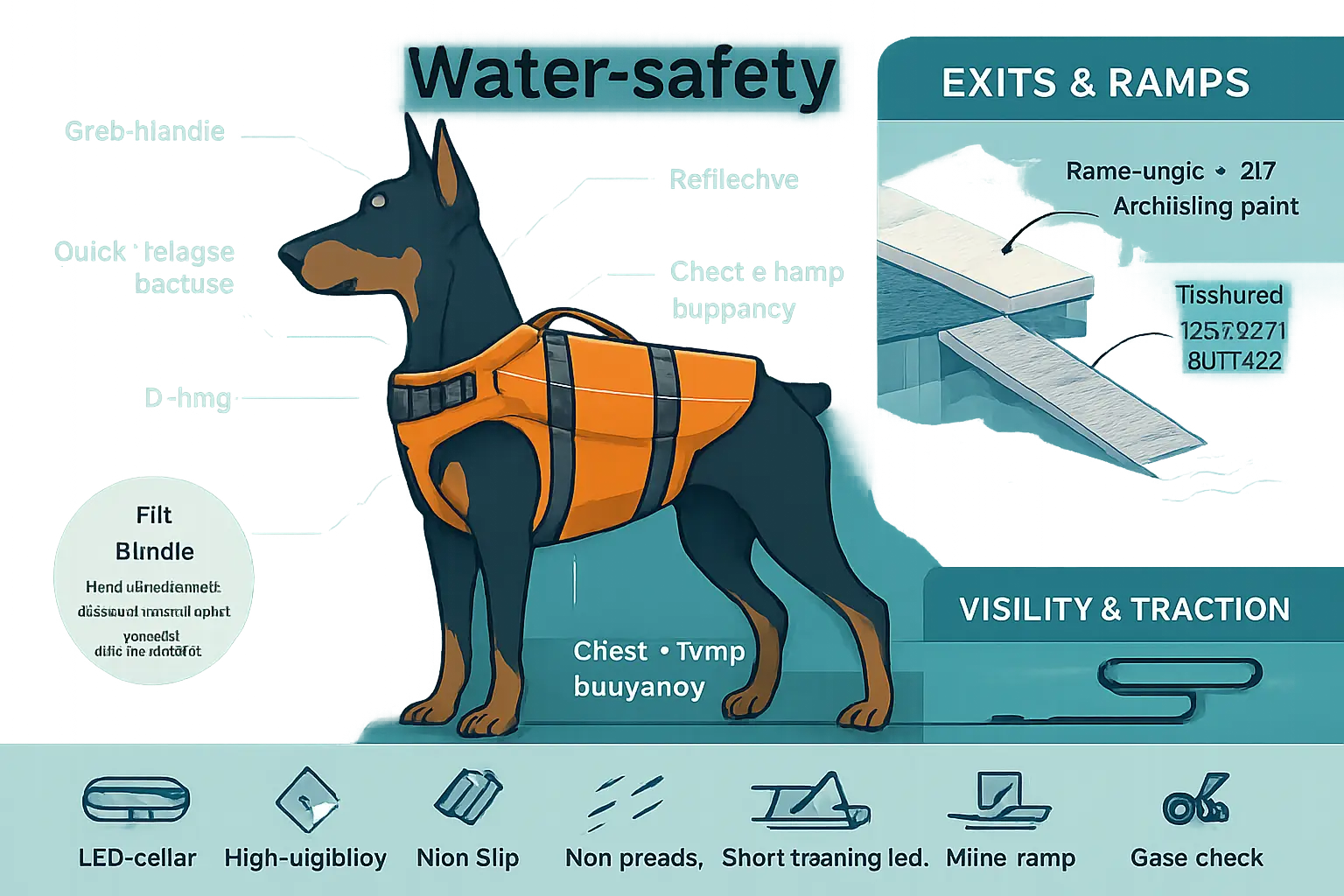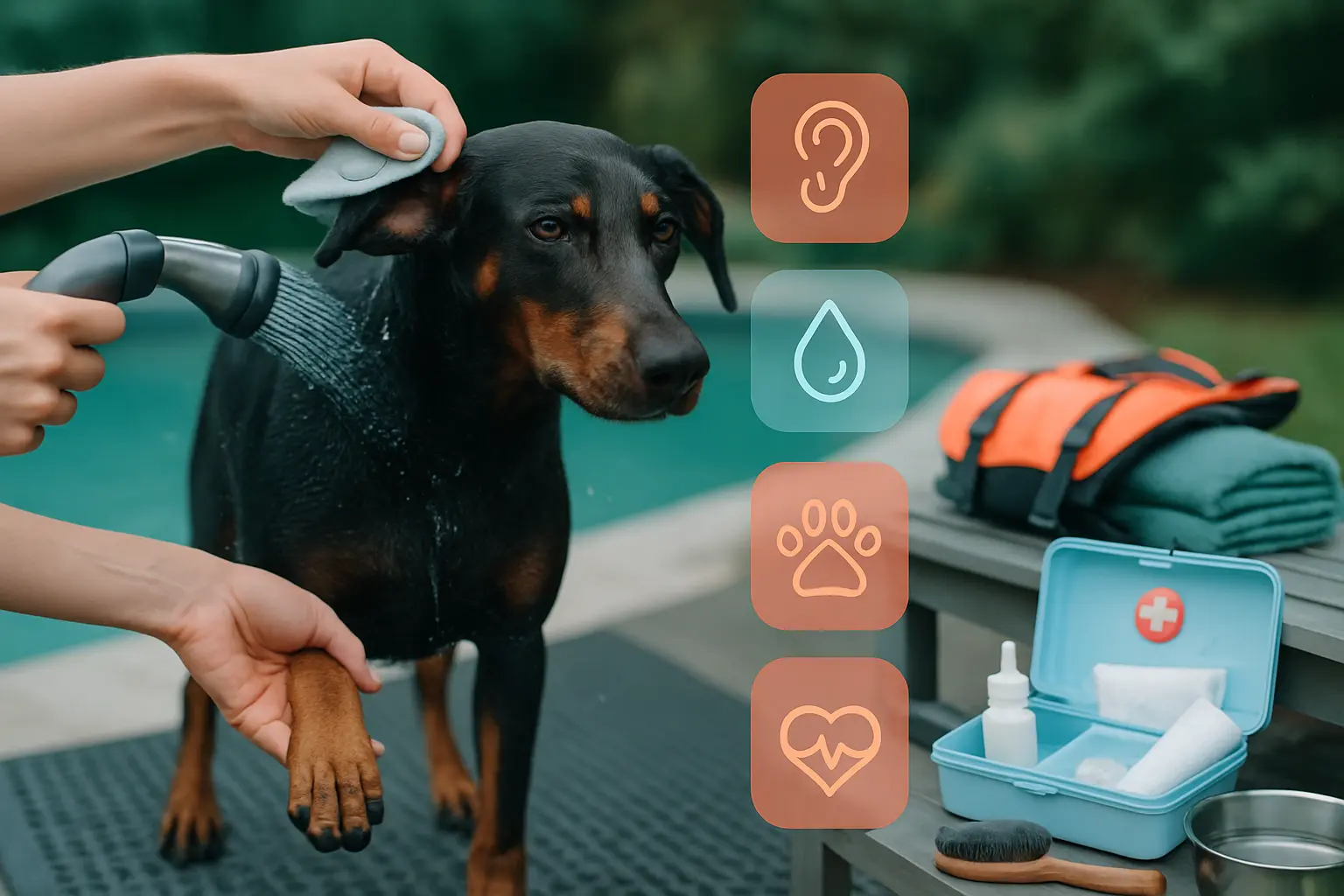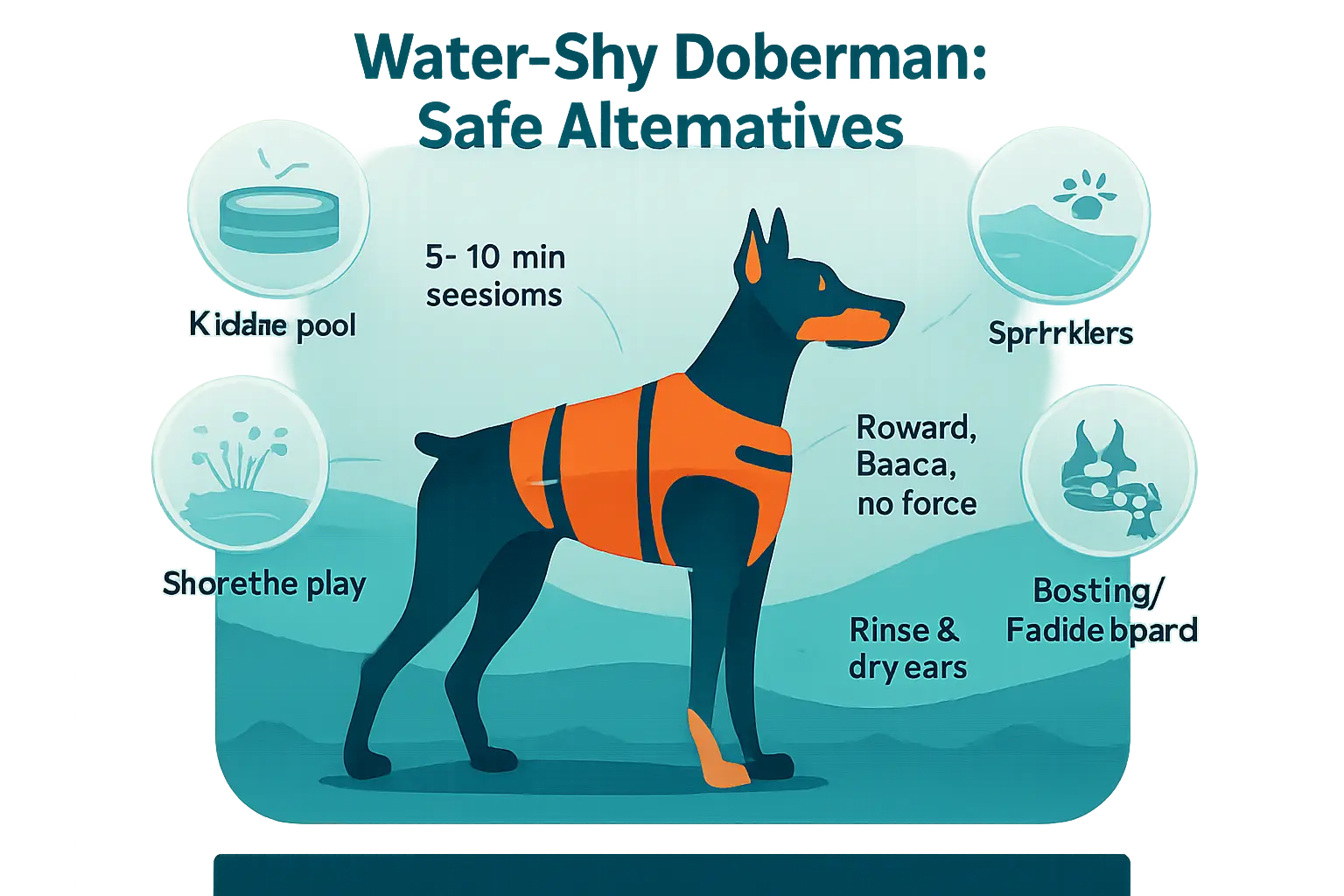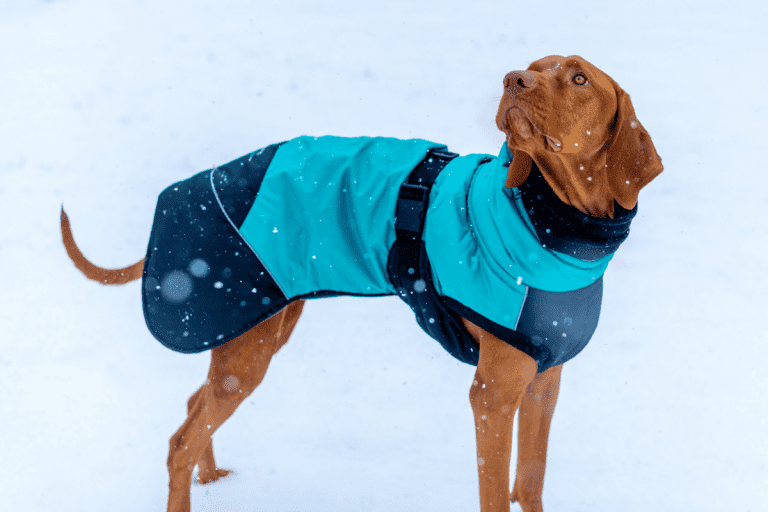Can Dobermans Swim? Safety, Training & Health Tips
Last Updated on October 8, 2025
Can Dobermans swim? Many do, but not all. Deep chests and dense muscle lower buoyancy. Confidence varies by temperament. With calm introductions, positive reinforcement, and a snug life jacket, most learn safely.
Safety, Training & Health Tips covers step‑by‑step coaching, life jackets, pool ramps, and visibility gear. It explains water rules, temperature and current checks, and blue‑green algae risks. Owners also get aftercare for ears and skin, hydrotherapy guidance, and clear no‑swim warnings. Practical alternatives help Dobermans who dislike deep water.
Do Dobermans Swim Naturally?
Can Dobermans Swim? Safety, Training & Health Tips addresses whether this muscular, athletic breed takes to water naturally. Many Dobermans can paddle and stay afloat, but swimming is not instinctive for every dog of the breed. Owners should treat water introduction as a learned skill, not an automatic ability.
Early, calm exposure and positive reinforcement improve outcomes. Supervised, short sessions build confidence. Use a properly fitted life jacket, shallow entry points, and slow progress. For extra protection, consider accessories like dog ear plugs for swimming when sessions last or when water quality raises infection risk.
How Doberman anatomy affects buoyancy and paddling
Dobermans have a deep chest and powerful shoulders that promote strong forelimb strokes. Their long, lean bodies and narrow ribcages provide less natural buoyancy than barrel-chested breeds. Dense muscle mass also increases sink tendency. Paddling often looks efficient at the shoulders but less so at the hips, so propulsion can feel uneven. Dobermans lack highly webbed feet, so they rely on vigorous limb motion. Trainers focus on steady, horizontal body position and relaxed breathing to improve stroke efficiency.
Breed temperament and individual variation
Temperament shapes willingness to enter water. Confident, curious Dobermans often adapt quickly. Anxious or cautious individuals may resist, even if physically capable. Early socialization around safe water and reward-based lessons reduce fear. Past negative experiences create stronger avoidance, so trainers use desensitization rather than force. Each dog’s motivation—play, retrieving, or following an owner—affects learning speed.
Age, weight and medical conditions that change swimming ability
Puppies lack coordination and need close supervision. Senior dogs develop arthritis, hip dysplasia, or cardiac issues like dilated cardiomyopathy, which lower stamina and safety in water. Overweight dogs sink more and fatigue faster. Cold water and long sessions risk hypothermia. Always consult a veterinarian before starting aquatic exercise for dogs with known health problems. For safe practice, schedule short swims, provide rest, and ensure an easy exit from the water.
Step‑by‑Step: Teaching a Doberman to Swim
Teaching a Doberman to swim follows clear, progressive stages that prioritize safety and confidence. Start with short, positive sessions and steady progression. Use a properly fitted life jacket for early practice and always supervise from close range. Break training into micro‑goals: create a calm entry, encourage paddling, and establish reliable exits and recall. Maintain sessions under 10–15 minutes to prevent fatigue. Track progress with notes on comfort and stroke form, and adjust pace to the dog’s stress signals. Dobermans often carry deep chests and strong legs, which can help buoyancy but may also tire them if they overreach; watch for inefficient strokes and rest before exhaustion. Before heading to open water or a public pool, check local rules and bring basic first‑aid supplies. For owners preparing to travel with a dog or bring gear to sessions, see practical packing and safety suggestions at essential dog travel tips and gear for road trips. If the dog shows signs of persistent fear, consult a veterinarian or certified trainer to rule out medical or behavioral issues.
Preparing your dog (positive associations and life‑jacket familiarity)
Preparation focuses on building positive associations and making equipment familiar. Introduce a life jacket on dry land first. Let the Doberman sniff and wear it briefly while offering high‑value treats and calm praise. Gradually increase wear time so the jacket feels normal. Use toys and food to pair water and gear with rewards. Practice gentle handling around feet and belly to reduce sensitivity when the jacket goes on. Next, bring the dog to shallow water without forcing entry. Allow self‑directed exploration while reinforcing calm behavior. Consider a small kiddie pool for early exposure; it offers controlled depth and easy exits. A useful resource on choosing pools and water gear is 10 refreshing puncture-proof dog pools. Avoid full‑body restraint that causes panic. Each successful, short interaction builds trust and reduces future resistance to deeper water.
Choosing the safest place to start (shallow, calm, gradual slope)
Select a learning site with minimal hazards. Ideal locations have a gradual slope into water, calm surface, and slow current. Natural ponds with muddy bottoms or sudden drop-offs are poor choices. A private swimming pool or a quiet lake inlet works best. Confirm water quality to avoid bacterial or algal risks. Shorelines with firm footing prevent slips and help the Doberman feel steady as it enters. Avoid busy beaches where waves and other dogs add stress. If using a public pool, ensure pool rules allow dogs and that pool steps exist for easy exit. For tips about water edges and beach safety, refer to practical beach guidance found at tips for taking cats to the beach, which also highlights hazard awareness adaptable to dogs. Always check wind and temperature; cold water can impair swimming ability and raise hypothermia risk.
Progressive coaching: feet → wading → supported paddling → independent swims
Follow a clear coaching progression to maintain confidence and build skill. Phase 1: feet only. Encourage the dog to place front paws in the water while rewarding calm behavior. Phase 2: wading. Walk a few steps into shallow water while the dog follows at its own pace. Offer treats and a favored toy to reinforce forward movement. Phase 3: supported paddling. Use a life jacket and support under the chest to let the dog experience paddling movements without full body load. Keep hands light to avoid teaching reliance on support. Phase 4: independent swims. Move slightly away and call the dog back to shore, rewarding successful returns. Short, frequent sessions work better than long workouts. Monitor breathing and stroke efficiency; if the dog paddles asymmetrically or yawns excessively, stop and rest. For dogs with anxiety around new experiences, owners may find strategies at 9 natural ways to remedy your dog’s travel anxiety useful for calming techniques transferable to water training.
Teaching reliable exits, recall and pool‑stair use
Exits and recall form the safety net for any swim session. Teach the dog a clear exit cue like “out” or “steps” paired with the physical motion of using stairs or a gradual ramp. Practice repeatedly at shallow depth until the dog moves to the exit on cue without hesitation. For pools, guide the Doberman up and down steps several times while rewarding each successful use. Reinforce recall on land first, then from short distances in water, gradually increasing distance as reliability improves. If the dog struggles to climb, break the task into smaller steps: step‑to‑step rewards, then partial ascents with support. Large dogs sometimes need a brief lift; techniques for safe handling translate well from vehicular lifting practices—see practical lifting guidance at 5 steps to safely lift a large dog into a car. Always end sessions on a positive note and towel‑dry promptly to avoid ear or skin issues. Regular rehearsal cements exits and recall under stress.
Essential Safety Gear and Pool Modifications

Dobermans that swim safely need the right equipment and pool setup. This section covers gear choices and practical pool or boat modifications that reduce risk. Each subsection focuses on a specific safety area: life jackets, exits and ramps, then visibility and traction. Owners should pair gear choices with short training sessions so the dog accepts and uses equipment reliably.
How to pick and fit a canine life jacket (features to prioritize)
A well-fitted life jacket keeps a Doberman buoyant without restricting movement. Prioritize a model with a strong grab handle, adjustable straps, and buoyant panels that support the chest and rump. Choose a vest cut to match a deep-chested, narrow-waisted build; many manufacturers list measurements—measure girth just behind the front legs and neck circumference.
Look for: sturdy quick-release buckles, neoprene or quick-dry fabric, and a D-ring for leash attachment. Bright colors improve visibility. Try the jacket on dry first, then test in shallow water with the dog wearing a snug collar or harness underneath. The jacket must not ride up or push the head back; if it does, size down or try a different shape.
Replace any jacket with frayed straps or compressed foam. For travel-focused gear suggestions and complementary items, see essential dog travel tips and gear for road trips. Regularly rehearse putting the jacket on, and pair fitting with short positive-reinforcement sessions.
Pool ramps, dog stairs, ramps for boats and leash/handle usage
Clear, secure exits matter as much as flotation. Install a gradual ramp or low-rise dog stairs at the shallow end so a Doberman can exit without jumping. Ramps should have a textured, non-slip surface and a gentle slope—aim for under a 25-degree angle where possible. Anchoring prevents movement when the dog climbs.
For boats, use a marine-rated telescoping ramp or platform that extends past the transom and offers traction. Position the ramp where the dog naturally approaches and steady it during initial practice runs. When lifting or assisting a large dog, use a harness or handle and employ proper lifting technique to avoid strain—see guidance on safe lifting methods in 5 steps to safely lift a large dog into a car.
Use a short, slip-resistant leash connected to the life jacket’s grab handle during training. Never tether a dog to a fixed object in the water. Teach the dog to approach and climb the ramp with treats and repetitions, gradually increasing water depth and distractions.
Visibility, reflective gear, and grips for slippery surfaces
Good visibility and solid traction reduce accidents around water. Equip a Doberman with brightly colored, reflective gear—life jackets and harnesses with reflective strips and built-in LEDs help during low light. Attach a floating light or LED collar when swimming near dusk or in open water.
Improve footing with textured strips on pool edges, non-slip stair treads, or rubber mats on docks. Paw protection like booties or traction balm helps on hot, slippery, or rough surfaces. Keep nails trimmed and fur between pads short to improve purchase. For boats and ramps, choose marine-grade non-slip tape or textured rubber that resists algae and water wear.
Inspect gear before each outing and replace anything that loses reflectivity or becomes slick. For layered weather protection and added visibility, consider a waterproof coat designed with belly protection and reflective trims—see options at waterproof dog coats with underbelly protection. A quick pre-swim gear check prevents most avoidable mishaps.
Water Safety Rules for Every Swim Session
Dobermans can enjoy water, but every swim requires clear rules to reduce risk. Keep sessions structured, check conditions before entry, and have a rescue plan ready. Use a canine life jacket for early learners, deep water, or long swims. These rules protect dogs and owners and make training safer and more productive.
Supervision, session length and pacing to avoid fatigue
Constant supervision matters. A handler should stay within arm’s reach of young, inexperienced, or tired dogs. Start with short sessions of three to five minutes of steady swimming, followed by rest on shore or a shallow platform. Gradually increase time with frequent breaks, watching for slowed paddling, erratic strokes, or sinking hips—signs of fatigue. Adjust pacing for age and conditioning: puppies, seniors, and dogs recovering from illness need shorter, gentler sessions. Rotate active play with calm float time to prevent overheating and overexertion. Use a brightly colored canine life jacket for visibility and added buoyancy. For guidance on useful gear and trip planning for dogs, see essential dog travel tips and gear for road trips. Consider a short cooling-off period after high-energy play and always offer fresh water to prevent drinking from unsafe sources.
Temperature, currents and environmental hazards to check beforehand
Check water temperature before letting a Doberman enter. Cold water under 60°F can cause rapid hypothermia, while hot surfaces and high humidity raise heatstroke risk. Observe local currents and tidal charts at beaches; rip currents can overwhelm even strong swimmers. Scan for hazards: sharp rocks, sudden drop-offs, submerged debris, boat traffic, and algae blooms. Avoid areas with visible foam, dead fish, or strong chemical smells. Inspect shore access—steep banks make exits difficult for exhausted dogs. Protect pads from hot sand or rough surfaces with short sessions or dog booties. If using a pool, ensure secure fencing and a safe ramp or steps. For beach-specific hazard considerations and how to assess a shoreline, review tips for taking cats to the beach, which also lists shore checks useful for dog owners. When uncertain, choose calmer, controlled water like fenced dog pools or shallow lakes.
Recognizing distress and basic rescue steps (including when to get help)
Recognize distress early: frantic, splashing paddling, low or submerged head, weak strokes, gasping, or inability to keep nose above water. Pale or blue gums indicate poor oxygenation and require immediate action. If a dog shows these signs, call for help and, if trained, use a long rescue pole, buoyant board, or life ring to guide the dog toward shore. Avoid jumping into rough water unless a person has lifeguard or swift-water rescue training; untrained rescues risk two casualties. Use a leash, towel, or leash looped under the chest as an improvised harness to pull the dog to shallow ground if safe. Once out, clear airways, check breathing, and warm the dog with dry towels and a blanket. Transport to a veterinarian immediately for cyanosis, prolonged weakness, or swallowing water. For safe lifting techniques when a large dog needs help getting into a vehicle after a rescue, consult 5 steps to safely lift a large dog into a car. Keep emergency contacts and a basic pet first-aid kit nearby during every swim session.
Health Risks and Aftercare

Dobermans can enjoy water, but owners must manage specific post-swim risks. Clear steps reduce infection, chemical exposure, and other hazards. The guidance below helps owners spot trouble early and complete a reliable aftercare routine.
Identifying toxic water (blue‑green algae) and preventing ingestion
Blue‑green algae (cyanobacteria) can appear as bright green scum, foam, or paint-like streaks on lakes and ponds. If water smells musty or looks discolored, keep the dog out. Prevent ingestion by offering fresh water before and after swims and using a short lead near suspicious shorelines. If vomiting, tremors, seizures, or sudden weakness develop, seek emergency veterinary care immediately.
Preventing swimmer’s ear, skin irritation and paw damage
Wet ears, scratched skin, and cut paw pads increase infection risk. Dry the ear canals gently and check for redness, odor, or head shaking. Consider protective options such as ear covers or dog ear plugs for swimming for dogs prone to ear problems. Inspect skin folds, underbelly, and between toes for irritation or foreign material after each swim.
Water intoxication (hyponatremia) — signs and urgencies
Water intoxication occurs when a dog swallows too much fresh water while swimming. Early signs include nausea, excessive drooling, lethargy, and disorientation. Advanced signs are seizures and collapse. If any of these symptoms occur, treat the situation as an emergency and get veterinary attention without delay.
Post‑swim rinsing, drying and grooming checklist
Follow this concise checklist after every swim:
- Rinse coat and paws with clean, fresh water to remove algae, salt, and chlorine.
- Blot-dry coat and open ear canals with a soft towel; avoid deep cotton swabs.
- Brush the coat to remove trapped debris and speed drying.
- Inspect paw pads and trim excess fur between toes if needed.
- Schedule a vet visit for any persistent redness, discharge, or behavioral changes.
If owners notice anything abnormal, contact a veterinarian promptly. Regular preventive checks and consistent aftercare keep Dobermans safer and more comfortable around water.
Benefits of Swimming and When to Use Hydrotherapy
Swimming gives Dobermans a powerful way to build strength and stamina without extra joint stress. Can Dobermans Swim? Safety, Training & Health Tips emphasizes that water exercise combines cardiovascular conditioning with muscle strengthening while minimizing impact on hips and elbows. Physical therapists and veterinarians use hydrotherapy to speed recovery after orthopaedic surgery, reduce pain from osteoarthritis, and support weight-loss plans.
Hydrotherapy differs from casual swimming because clinicians design sessions to meet medical goals. A controlled pool lets a therapist set water depth, temperature, and resistance. Therapists measure progress and adjust intensity, so sessions stay safe and effective. Owners should look for certified canine hydrotherapy providers and confirm pool sanitation and safety features.
For owners who want a safe at-home option, consider durable, shallow dog pools that resist punctures and provide gradual entry. See 10 refreshing puncture-proof dog pools for suitable portable options. Before starting any water program, owners should consult a veterinarian for a tailored plan and clearance.
Low‑impact fitness, joint rehabilitation and weight management
Swimming delivers efficient low-impact fitness for Dobermans. Buoyancy reduces load on joints while the dog uses more muscle groups than during walking. That combination helps maintain lean mass and improves range of motion.
Typical benefits seen in clinical and home settings:
- Improved hip and shoulder mobility without ground reaction forces.
- Progressive muscle strengthening around surgical repairs.
- Faster calorie burn for overweight dogs while protecting joints.
Sessions usually start short — five to ten minutes of steady swim or assisted treadmill work — and increase by a few minutes every week. Owners should monitor breathing rate, limb symmetry, and fatigue. Use a properly fitted canine life jacket for unsteady swimmers. Track weight and girth measurements to quantify progress and share those with the veterinarian or physiotherapist for ongoing adjustments.
When vets recommend hydrotherapy and how it differs from casual swimming
Veterinarians recommend hydrotherapy for specific clinical goals. Common indications include post-operative recovery for cruciate ligament repair, chronic osteoarthritis, neurological deficits that impair gait, obesity requiring safe exercise, and conditioning for sport dogs. A formal assessment precedes therapy to identify contraindications and set measurable targets.
Hydrotherapy differs from casual swimming in three key ways:
- Structure: A plan prescribes frequency, duration, and exercises linked to recovery milestones.
- Supervision: Trained staff observe gait, muscle recruitment, and vitals during sessions.
- Environment: Pools and underwater treadmills control temperature and resistance for reproducible progress.
Owners should request written goals and periodic reassessments. Hydrotherapy complements veterinary treatments; it does not replace necessary medications or surgical care. When unsure, opt for a professional referral to a certified canine hydrotherapist.
Contraindications: when not to let a Doberman swim
Owners must avoid swimming in several situations that risk worsening health. Clear contraindications include uncontrolled seizures, severe heart or respiratory disease, and open surgical wounds before veterinary approval. Active skin or ear infections pose contagion and delayed-healing risks. Puppies with incomplete vaccinations need protection from waterborne pathogens.
Pregnancy often requires special consideration; vigorous swimming or therapeutic protocols may not suit every pregnant dog. For guidance about moving or caring for a pregnant dog while traveling, see can a pregnant dog travel by car? Owners should discuss pregnancy stage and exercise limits with the veterinarian.
If a Doberman has a condition that prevents safe swimming, a veterinarian can recommend alternatives. Land-based physiotherapy, controlled leash walks, and therapeutic massage still provide conditioning without aquatic risks. Always obtain veterinary clearance before resuming or beginning water work.
Alternatives and Next Steps if Your Doberman Hates Water

When owners consult “Can Dobermans Swim? Safety, Training & Health Tips,” the focus often shifts to practical alternatives for dogs that refuse water. Dobermans that dislike swimming still benefit from cooling and enrichment activities that avoid deep water. Start by prioritizing safety: monitor heat, provide shade, and keep fresh water available. Use a gradually paced plan that pairs mild water exposure with high-value rewards and short sessions. For travel days or on-water outings, choose options that minimize stress and risk. Gear such as well-fitting life vests, non-slip ramps, and protective boots reduce injury and anxiety. Owners should also check health issues before pushing water work — joint pain, ear infections, or heart conditions can cause avoidance.
For guidance on safe travel and appropriate gear for outings, owners can reference essential dog travel tips and gear. That resource helps plan shore-based activities and secure transport to supervised water sessions. If gradual exposure and short shore sessions fail, consider the structured steps in the subtopics below before escalating to formal lessons.
Kiddie pools, wading, sprinklers and shoreline play as substitutes
Shallow-water substitutions suit many Dobermans. Kiddie pools, sprinklers, and gentle shoreline play replicate the cooling and play elements of swimming without forcing full immersion. Place a puncture-resistant pool on soft ground and keep water shallow at first. Encourage approach with treats and toys; reward any calm interaction with the water. Sprinklers work well for dogs who prefer running through moving water rather than standing in it.
At natural shorelines, choose gently sloping banks and avoid strong currents. Use a long leash and harness instead of a collar. Limit sessions to five to ten minutes early on, watching closely for signs of stress. Rotate activities to keep interest high: fetch with a floating toy at the water’s edge, scent games on wet sand, or cooling mats between water breaks. For ideas on durable shallow-play equipment, see this guide to puncture-proof dog pools. Owners should always rinse and dry ears after any water exposure to reduce infection risk.
Boating, paddleboarding and safe on‑water options with a life vest
Some Dobermans tolerate being on the water even if they refuse to swim. Boating and paddleboarding keep the dog above water while still offering a safe aquatic experience. Fit a coast-guard‑approved canine life vest with a handle. Test the vest on land for comfort and mobility before any trip. Teach the dog to climb onto the boat or board from a dock or low step, using treats and calm, consistent cues.
Use non-slip matting and secure a short tether to a harness when near open edges. Paddleboarding requires prior balance exercises on dry ground. Plan short rides in calm conditions and avoid rough water. Keep a buoyant throw line and a pet first-aid kit on board. For protective swimming accessories such as ear protection and post-water care, owners may consult resources on dog ear plugs for swimming. If the dog shows panic in moving craft, stop sessions and try shoreline acclimation first.
When to hire a professional trainer or enroll in formal lessons
Professional help becomes necessary when fear responses escalate beyond simple avoidance. Signs that a Doberman needs a trainer include frantic attempts to escape, aggression toward handlers near water, or persistent shutdown despite gradual desensitization. A certified trainer can design a behavior modification plan that uses counterconditioning and positive reinforcement.
Look for trainers with documented experience in canine water introduction and certifications such as CPDT-KA. Group lessons at a controlled facility or private sessions at a calm pool offer structure and controlled progression. Trainers can also screen for underlying medical contributors and coordinate with vets when necessary. For owners managing anxiety more broadly, strategies and natural remedies can complement formal training; see this post on natural ways to remedy dog anxiety.
As a next step, owners should request references, observe a training session, and confirm humane, reward-based methods. If quick improvements are essential for planned outings, schedule lessons early and combine them with the substitution strategies described above.
Quick Prep Checklist and Common Owner Questions
Dobermans often take to water, but preparation makes swims safe. Owners should assemble gear, confirm health readiness, and plan a clear exit route before the dog ever reaches deep water. A short checklist prevents common mistakes like missing a life jacket or not testing the ramp.
Essential prep steps include a properly fitted canine life vest, a non-slip ramp or steps, a short training leash for controlled introductions, and a dry towel for post‑swim warming. For owners who plan to use a portable pool, consider durable, puncture-resistant options to avoid sudden deflation or injury. See a selection of robust options at 10 Refreshing Puncture-Proof Dog Pools.
Common owner questions often ask whether Dobermans need special training to swim, how pool chemicals affect coat and skin, and whether a large dog can exit a standard pool unaided. Address these by assessing each dog’s strength, scheduling short supervised sessions, and modifying exits to suit the dog’s height and mobility. A final quick step: record emergency contacts in a waterproof pouch kept near the water.
Pre‑swim checklist (equipment, health checks, exit plan)
Before the first swim, run through a concrete checklist. Equipment: life jacket sized for chest girth, a secure leash, a harness with a handle, a towel, and fresh drinking water. Add a canine first‑aid kit with gauze, antiseptic, and a blanket.
Health checks: confirm vaccinations and parasite control. Palpate hips and shoulders for pain. Watch for respiratory or cardiac issues that make exertion unsafe. If the dog has a history of joint problems, consult a vet first.
Exit plan: test the route out of the water. If using a pool, install a ramp or shallow steps. Practice guiding the dog up the ramp on dry land before water exposure. Mark the nearest human exit and keep a quick‑release leash for fast control. For gear ideas related to ear protection and safe water practice, review options at Dog Ear Plugs for Swimming.
Short answers: puppies, eating before swimming, and pool chemicals
Puppies: wait until core vaccinations finish. Most vets recommend waiting until 12–16 weeks, then introduce short, supervised swims. Begin in shallow water where the puppy can touch the bottom.
Eating before swimming: avoid heavy meals within one to two hours of exercise. Light snacks are fine. A full stomach increases the risk of discomfort and, rarely, bloat in deep, vigorous activity.
Pool chemicals: chlorine and bromine irritate eyes and skin with prolonged exposure. Rinse the coat with fresh water after every swim. Keep swims short in treated pools and monitor for redness or itching. Natural bodies of water carry different risks, such as blue‑green algae and parasites; avoid suspicious or stagnant water. For protection in cool water, owners can consider protective outerwear options like waterproof dog coats with underbelly protection.
Emergency contact list and how to prepare for a rescue
Create a concise emergency contact list and keep it visible near every swim area. Include: primary veterinarian, nearest 24/7 emergency animal hospital, local animal control, and a nearby friend who can assist in a rescue. Store numbers in a waterproof sleeve.
Rescue prep: keep a buoyant throw rope, a life ring, and a sturdy ladder or ramp by pools and open water. Train two people on simple canine rescue moves: secure the harness, lift from the flank and chest, and slide the dog onto a flat surface. Practice a staged extraction on land so the dog remains calm during a real event.
Basic post‑rescue steps: check airway, breathing, and circulation. If the dog is not breathing, begin canine CPR and rush to an emergency clinic. For travel‑related emergency planning and gear that helps in roadside or remote rescues, consult resources like Essential Dog Travel Tips and Gear for Road Trips. Keep a compact CTA card visible: “If unresponsive, perform CPR and call listed vet immediately.”
Summary
Can Dobermans Swim? Safety, Training & Health Tips explains that many Dobermans can learn to swim, but the skill is not automatic. Their deep chests, lean frames, and dense muscle can reduce buoyancy, so owners should introduce water gradually with a focus on confidence, calm pacing, and reliable exits.
The post outlines a clear training progression, essential gear and pool modifications, session rules to prevent fatigue or hypothermia, and an aftercare routine to protect ears, skin, and paws. It also covers when hydrotherapy is appropriate, medical red flags that make swimming unsafe, and practical alternatives for dogs that dislike deep water.
Key Takeaways
- Swimming is taught, not guaranteed: Owners should use a canine life jacket, calm shallow entries, and short, supervised sessions to build skill and confidence.
- Anatomy and health matter: Deep chests, lean bodies, age, weight, and conditions like arthritis or cardiac disease affect buoyancy and stamina; veterinary clearance is wise for at-risk dogs.
- Progressive training works best: Move from feet-only to wading, supported paddling, then short independent swims; teach exits, recall, and pool-stair use early.
- Safety setup prevents emergencies: Fit a life jacket correctly, provide non-slip ramps or steps, use high-visibility gear, check temperature and currents, and keep a rescue plan and first-aid kit ready.
- Aftercare reduces complications: Rinse after every swim, dry ears, and inspect skin and paws; watch for blue‑green algae exposure and water intoxication, and seek veterinary help for concerning signs.
- Hydrotherapy and alternatives: Clinician-guided hydrotherapy supports rehab and weight management, while kiddie pools, shoreline play, or boating with a vest suit dogs that dislike deep water.
FAQ
- What makes Dobermans less natural swimmers than some breeds? Their deep chests, lean, muscular build, and less webbing on the feet reduce natural buoyancy and propulsion. Ability varies by temperament, fitness, and prior experiences.
- How should owners start teaching a Doberman to swim safely? Begin with life‑jacket acclimation on land, then use calm, shallow water and high‑value rewards. Progress from wading to brief supported paddling and short independent swims, reinforcing exits and recall at every step.
- What safety gear does a Doberman need for swimming? A well‑fitted canine life jacket with a handle, non‑slip ramp or steps, a short training leash with a secure harness, and reflective or LED visibility gear. A basic pet first‑aid kit and optional ear protection add extra safety.
- Why can cold water and certain health issues be risky? Cold water (under about 60°F) increases hypothermia risk and reduces muscle efficiency. Conditions such as arthritis, cardiac disease, ear or skin infections, or open wounds can make swimming unsafe without veterinary guidance.
- How is hydrotherapy different from casual swimming? Hydrotherapy is clinician‑directed with controlled temperature, depth, and resistance to meet medical goals like post‑operative rehab or weight loss. Sessions are structured, monitored, and adjusted for progress and safety.







